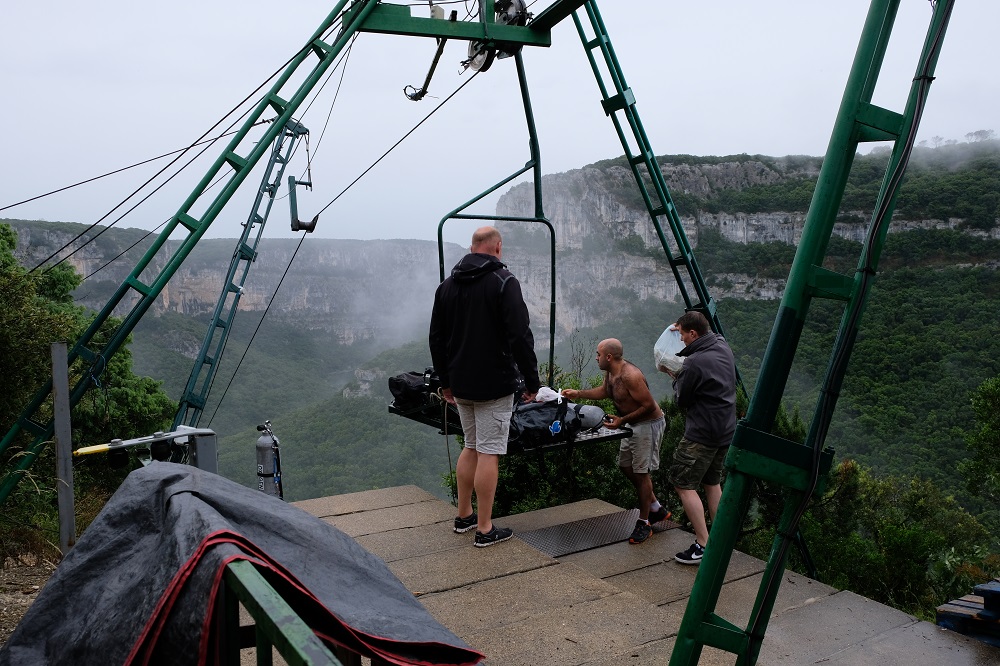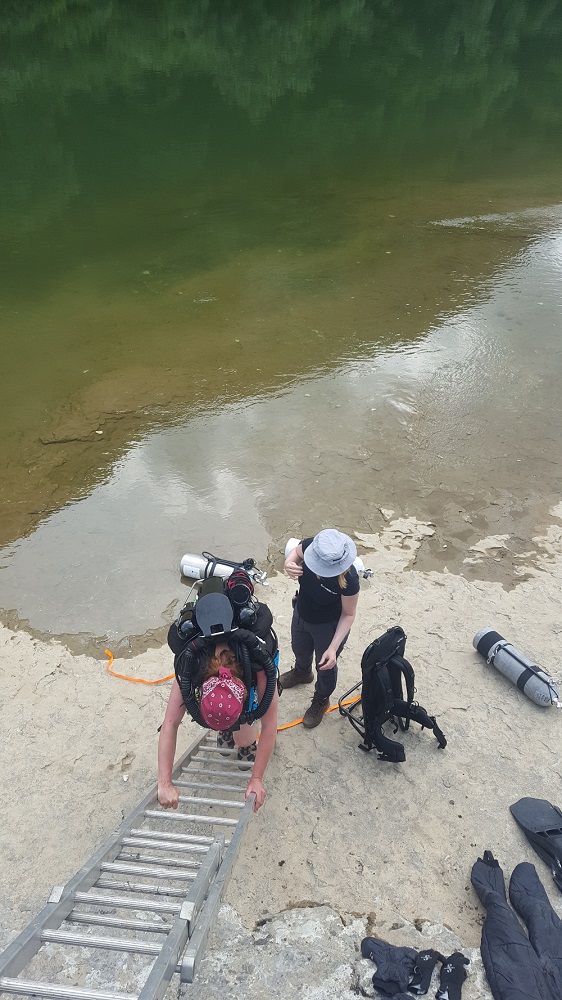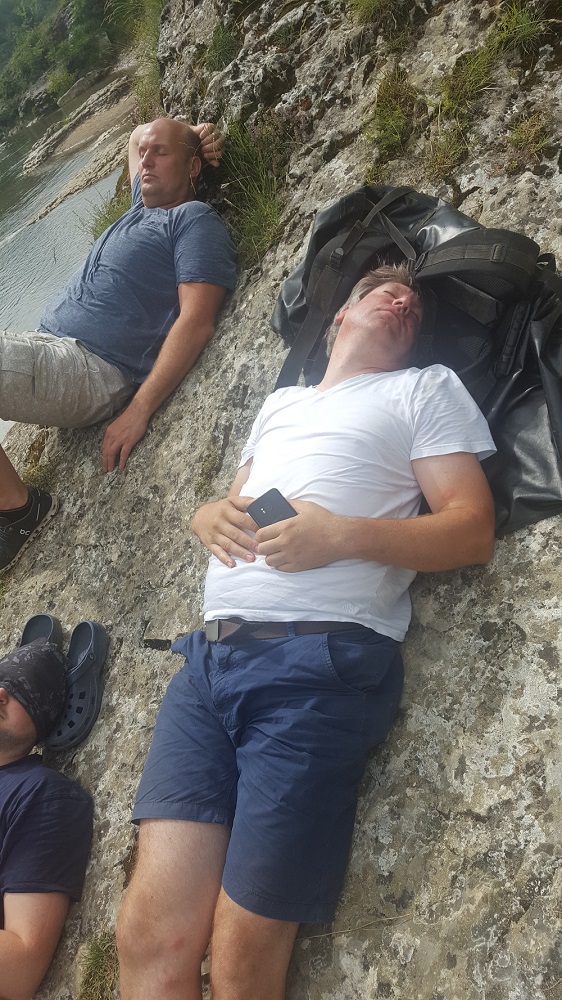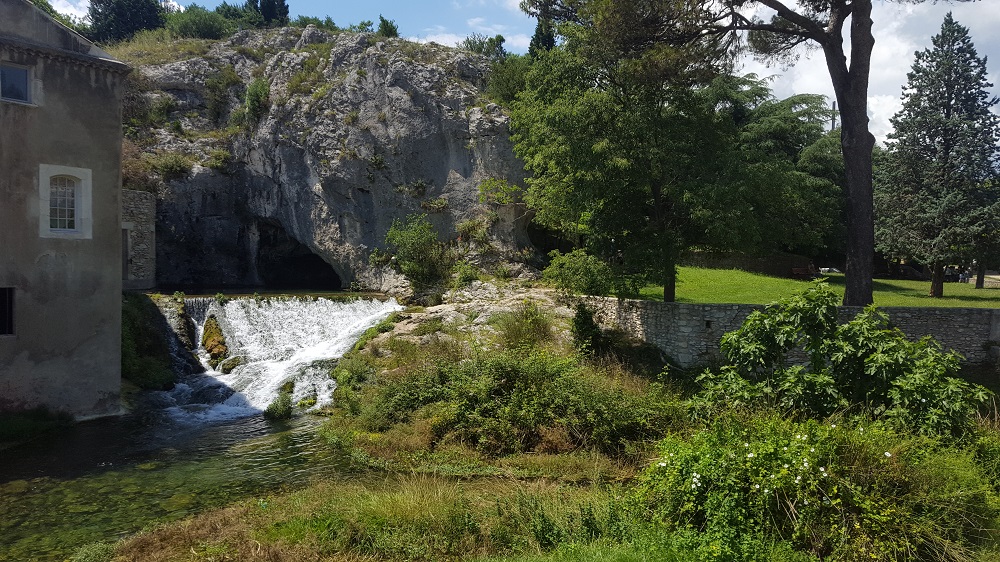Source du Castor - 2018
Team: Steffen, Zeljka, Marc, Heinke, Max, Marcel, Tom, Fabi, Dirk
„Wann hast du das letzte mal gezeltet ?“
„Weiß nicht – bei der Bundeswehr!?“
With this dialogue, we arrived at the campsite in the Ardeche after a 10 hour drive, from all corners of Germany. The campsite itself is located directly on the Ardeche - 900 m from the Source du Castor. The equipment can only be transported to the campsite by cable car. The ten-minute descent is steep and arduous.


Once there, a culture shock was imminent: The tents, beautifully depicted on the Internet, gave the impression that they had already had their best days in the days of Konrad Adenauer. And if you turned around too quickly on the slatted frame, the slats flew out and you lay on the floor.
But the tiredness and the fact that again a steep ascent could stand let even these tents appear as luxury domicile. And besides, we were there to dive. So on the first evening, we set out on foot and by drone to locate the cave entrance and make initial plans for the next day. After a few minutes we had discovered the entrance on the other side of the river. Equipped with swimming trunks and masks, Max and Fabi swam across the river for a closer look. The cave itself has two entrances, one under water and one above water. Due to the onset of dusk, we let it go for the day and returned to base camp. Here the grills were fired up, dinner was eaten, and plans were made until we all went to bed at bedtime.
The next morning we started out full of beans. After a delicious baguette breakfast, part of the team had to climb back up the mountain to the vehicles. Because a lot of material still had to be driven down to the valley. The other team members started to put the plans of the previous evening into action.
Our plan was to bring all the equipment to the cave in canoes. And true to the motto "Among the blind, the one-eyed man is king", a team was put together according to a best selection, which had some experience in canoeing. Unfortunately, the ambitious project failed after only 5 minutes in the strong current. The canoe capsized together with the 3 crew members. These fight afterwards in the current against the sinking canoe. Unfortunately, they were on the other side of the river, so that help was not forthcoming. After about 15 minutes, the damaged canoe and its crew could be rescued from the Ardeche.
After this event it was decided to drag the equipment on foot through dense vegetation, beach and flooding places to the next best gravel bank. From there, however, the cave was still about 200m away on the other side of the river.
Our first scouting team, consisting of Max and Fabi, got ready to dive. The plan was to ride together with light luggage on a scooter to the cave entrance. However, we had completely underestimated the power of the Ardeche and the high water level. Hardly had the two divers in the pack moved away from the bay, they were also driven directly downstream. Also alone it was not possible to get out of this bay near the cave. Therefore we decided to start one bay further upstream. Here, however, a rocky outcrop had to be climbed over. Thanks to the friendly support of the campground operators, we were able to set up a ladder here and thus climb down the approximately 2m high wall. By this move to the new base camp 2 we had saved ourselves another 50 m water distance and had no more too strong currents. The two scouts could finally drive to the cave with 2 scooters.
The scouting team could hardly believe their eyes: very clear water and great visibility were to be found. However, also a lot of leaves and wood remains. The beavers (French Castor) have done a "great" job here. The cave is of an impressive size. It remains large and the very bright rock with fossil inclusions reflects in the light of the lamps.
At the barbecue and beer in the evening, the whole team feverishly awaited the next days.


The next morning made the whole team sweat. A lot of material, stages, suits, double devices, rebreathers, had to be transported the good 900 m to base camp 2. Here it was time for the entire team to "get to work". Quickly the necessary material was in place and so the OC team consisting of Marcel and Tom started to explore the front area of the cave exactly and to improve the line situation if necessary. This was also urgently necessary. Old lines were hanging in shreds from the ceiling. The main line consisted in sections of up to four partial segments, some of which were knotted together. And so the team began to remove unnecessary lines. However, it quickly determined that the main lines would not need to be isolated, but if so, would need to be completely relaid. The extent of the cave also became apparent during the advance into the cave.
Directly after the OC team, the second rebreather team, consisting of Steffen and Heinke, explored the cave a little deeper. They were also impressed by the size and structure of the cave.
In the joint statement in the evening at the barbecue and beer, everyone summarized their impressions under the project management of Steffen. The chaotic line situation was one of the topics of discussion.
Together we decided to use the next day to prepare for an EOL dive. The OC team was to clear the entrance of branches and brush, lay a clean connect to mainline and start laying a new mainline in the front area.
The CCR teams set up various bottle dumps, then the following day explored the cave with the scooters to the End of Line and beyond.
In the burning sun and heat, all the stages and doubles, scooters and backup scooters were then taken to the dive site and moved into the cave and their position by scooter. The OC team left their equipment completely in the cave after the work was done.
During the night, however, the weather changed. Where before sunshine was, much heavier, continuous rain. Now even the last pieces of clothing in the decrepit tents became clammy and damp.
The next day began with a visit from the French government in the form of Anke Lutz and a park ranger. Already in the run-up, when obtaining the permit, they discussed with us which exploration data the authorities would need. The project met with great interest.

Anke unfortunately also gave us bad news in the form of a warning. Heavy rainfall on the tributaries to the Ardeche will cause the water level to rise rapidly. A further increase of several meters is to be feared because the sluices of the reservoirs could be opened. We also received a link on which we could regularly look at and observe the water levels of the Ardeche.
With a heavy heart we decided to stop further exploration of the Castor that day and to remove the deposits from the cave. The risk of a backflow into the cave or the cave jumping on us was just too high. Also, the current of the Ardeche River was getting stronger.
On this day the CCR team consisting of Max and Fabi should make one last dive in the cave and see if they could reach the EOL. They dived a huge distribution hall, from which numerous loops and passages branched off to emerge in a 20m wide lake in an air bell. The team decided not to continue diving from here and to make their way back. On the way back they removed some of the double lines in the deep area and cleared up the line situation.
In the meantime, the other team members were already busy transporting the material that was no longer needed from base camp 2 back to the campsite.
In the evening, over a barbecue and beer, we decided that the exploration of Castor as a cavebase project would definitely continue.
We spent the next morning and noon transporting the material from the campsite up the mountain to our vehicles. The cable car had to make about 20 trips to do this. Part of the team helped load the cable car at the campsite, while the other half received the material at the mountain and sorted it for the different vehicles. When all the cars were loaded again, we set off to look for accommodation for the next few days. This search proved to be extremely complicated and it took us until the evening to find a small hotel.


While most of the team was busy looking for a place to stay, our scouts Max and Fabi set out to find a few little known caves. The caves we found were good for a fresh beer, but not suitable for diving.
After checking into our hotel rooms and freshening up, we looked for a restaurant in Bourg St Andéol...no barbecue tonight.
The next day we spent at the Goul de Tannerie and the Goul du Pont. Here all team members made some nice dives and were amazed by the length of the Tannerie and the shaft of the Goul du Pont. Some team members did a double dive directly. First into the Tannerie and from the source pot directly over and in the Goul du Pont a second time descend.


For the evening, a final dinner was planned in La Garde-Adhemaran. Around 23:30, the OC team Tom and Marcel already made their way home. The other team members stayed one more night and dived the Source de Marnade the next morning before heading home.
In this sense,
Your Cavebase
Gallery























